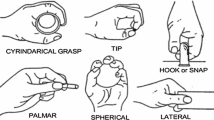Abstract
In bio-signal applications, classification performance depends greatly on feature extraction, which is also the case for electroencephalogram (EEG) based applications. Feature extraction, and consequently classification of EEG signals is not an easy task due to their inherent low signal-to-noise ratios and artifacts. EEG signals can be treated as the output of a non-linear dynamical (chaotic) system in the human brain and therefore they can be modeled by their dimension values. In this study, the variance fractal dimension technique is suggested for the modeling of movement-related potentials (MRPs). Experimental data sets consist of EEG signals recorded during the movements of right foot up, lip pursing and a simultaneous execution of these two tasks. The experimental results and performance tests show that the proposed modeling method can efficiently be applied to MRPs especially in the binary approached brain computer interface applications aiming to assist severely disabled people such as amyotrophic lateral sclerosis patients in communication and/or controlling devices.






Similar content being viewed by others
References
Andong, G. Zixing, C. & Yan, T. (2007). Distinguishing between left and right finger movement from EEG using SVM. The 1st International Conference on Bioinformatics and Biomedical Engineering ICBBE 2007, 562–565, Wuhan.
Andrzejak, R. G., Lehnertz, K., Rieke, C., Mormann, F., David, P., & Elger, C. E. (2001). Indications of nonlinear deterministic and finite dimensional structures in time series of brain electrical activity: dependence on recording region and brain state. Physical Review, 64(6), 061907.
Boostani, R., & Moradi, M. H. (2004). A new approach in the BCI research based on fractal dimension as feature and Adaboost as classifier. Journal of Neural Engineering, 1, 212–217.
Bradberry, T. J., Gentili, R. J., & Contreras-Vidal, J. L. (2010). Reconstructing three-dimensional hand movements from noninvasive electroencephalographic signals. The Journal of Neuroscience, 30(9), 3432–3437.
Burges, C. J. C. (1998). A tutorial on support vector machines for pattern recognition. Data Mining and Knowledge Discovery, 2, 121–167.
Cososchi, S. Strungaru, R. Ungureanu, A. & Ungureanu, M. (2006). EEG features extraction for motor imagery. Engineering in Medicine and Biology Society, 2006. EMBS ‘06 28th Annual International Conference of the IEEE, 1142–1145, New York.
Erdogan, B. (2009). A design and implementation of p300 based brain-computer interface (pp. 63–74). Middle East Technical University: MsC Thesis.
Gerstner, W., & Kistler, W. M. (2002). Spiking Neuron Models Single Neurons Populations Plasticity, Cambridge University Press, 44
Hayashi, H., Nakao, M., & Hirakawa, K. (1982). Chaos in the self-sustained oscillation of an excitable biological membrane under sinusoidal stimulation. Physics Letters, 88A(5), 265–266.
Hayashi, H., Ishizuka, S., & Hirakawa, K. (1985). Chaotic response of the pacemaker neuron. Journal of the Physical Society of Japan, 54, 2337–2346.
Hodgkin, A. L., & Huxley, A. F. (1952). A quantitative description of membrane current and its application to conduction and excitation in nerve. Journal de Physiologie, 117, 500–544.
Hyvarinen, A., & Oja, E. (2000). Independent component analysis: algorithms and applications. Neural Networks, 13, 411–430.
Kantz, H., & Schreiber, T., (2004). Nonlinear Time Series Analysis, second edition, Cambridge University Press, 65–74, 226
Lerner, B., Guterman, H., Aladjem, M., Dinsteint, I., & Romem, Y. (1998). On pattern classification with Sammon's nonlinear mapping an experimental study. Pattern Recognition, 31(4), 371–381.
Lotte, F., Congedo, M., Lecuyer, A., Lamarche, F., & Arnaldi, B. (2007). A review of classification algorithms for EEG-based brain-computer interfaces. Journal of Neural Engineering, 4, R1–R13.
Mandelbrot, B. B. (1982). The Fractal Geometry of Nature (pp. 3–142). San Francisco: Freeman Co.
Nan, X., & Jinghua, X. (1988). The fractal dimension of EEG as a physical measure of conscious human brain activities. Bulletin of Mathematical Biology, 50(5), 559–565.
Nunez, P. L., & Srinivasan, R. (2006). Electric Fields of the Brain The Neurophysics of EEG, Second Edition Oxford University Press , New York, 52–60, 374–375
Peitgen, H. O., Jurgens, H., & Saupe, D. (2004). Chaos and fractals: new frontiers of science, second edition, Springer-Verlag, 458, 185–192
Phothisonothai, M., & Nakagawa, M. (2006). EEG-Based Fractal Analysis of Different Motor Execution Tasks using Critical Exponent Method. International Journal of Biological and Medical Sciences, 1, 3.
Phothisonothai, M., & Nakagawa, M. (2008). EEG-Based Classification of Motor Execution Tasks Using Fractal Dimension and Neural Network for Brain-Computer Interface. IEICE—Transactions on Information and Systems E91-D, 1, 44–53.
Shinagawa, Y., Kawano, K., Seno, H., & Koito, H. (1991). Fractal dimension of brain wave. Mathematical Topics in Biology, 7(762), 133–141.
Soe, N. N., & Nakagawa, M. (2008). Chaos and Fractal Analysis of Electroencephalogram Signals during Different Imaginary Motor Movement Tasks. Journal of the Physical Society of Japan, 77, 4.
Stam, C. J. (2005). Nonlinear dynamical analysis of EEG and MEG: review of an emerging field. Clinical Neurophysiology, 116, 2266–2301.
Stam, C. J. (2006). Nonlinear Brain Dynamics. NewYork: Nova Science Publishers. 60.
Tekbaş, Ö. H., & Serinken, N. (2001). Transmitter fingerprinting from turn-on transients. Warsaw, Poland: NATO SET Panel Symposium on Passive and LPI Radio Frequency Sensors.
Tekbaş, Ö. H., Serinken, N., & Üreten, O. (2004). An experimental performance evaluation of a novel radio-transmitter identification system under diverse environmental conditions. Canadian Journal of Electrical and Computer Engineering, 29(3), 203–209.
Xingyuan, W., & Chao, L. (2006). Researches on chaos phenomenon of EEG dynamics model. Applied Mathematics and Computation, 183, 30–41.
Yom-Tov, E., & Inbar, G. F. (2003). Detection of movement-related potentials from the electro-encephalogram for possible use in a brain-computer interface. Medical & Biological Engineering & Computing, 41, 85–93.
Acknowledgments
The author would like to thank Fondazione Santa Lucia, Neurophysiopathology Laboratory staff for providing the MRP recordings and Önder Haluk Tekbaş for fractal dimension algorithm, and also their comments. This study was partly supported by The Scientific and Technological Research Council of Turkey (TÜBİTAK).
Author information
Authors and Affiliations
Corresponding author
Additional information
Action Editor: Simon Schultz
Rights and permissions
About this article
Cite this article
Bülent Uşaklı, A. Modeling of movement-related potentials using a fractal approach. J Comput Neurosci 28, 595–603 (2010). https://doi.org/10.1007/s10827-010-0242-7
Received:
Revised:
Accepted:
Published:
Issue Date:
DOI: https://doi.org/10.1007/s10827-010-0242-7




